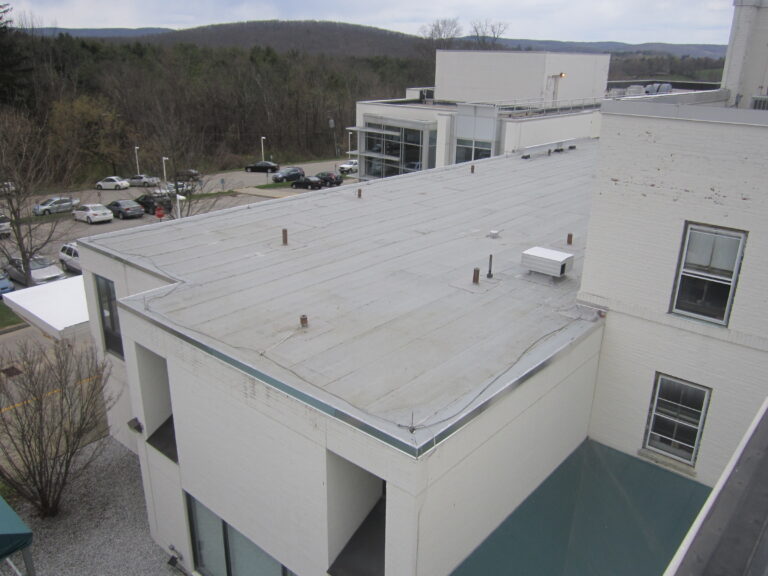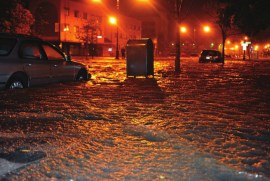
When Superstorm Sandy made landfall in the Northeast on October 29, 2012, the weather system delivered a devastating mix of wind and rain, causing unprecedented flooding, widespread power outages and the shutdown of cities throughout the region. Among the areas hardest hit by the storm was Lower Manhattan, where an extraordinary level of damage rendered many commercial buildings inoperative.
First-hand accounts of the severity and impact of the storm are jarring. For example, according to John Brandstetter, managing director of emergency planning firm The Brandstetter Group, “The most unexpected thing about the storm was the magnitude of water. Due to the storm surge and the flooding, some buildings in downtown New York had underground garages filled with millions of gallons of sea water, which is highly corrosive, or sewage. Some properties sustained upwards of $70 to $80 million in damage and many buildings were out of commission for up to six months because of water damage alone.” This flooding damage was compounded by the fact that many waste vac vendors in the area also were negatively affected by the storm, their trucks washed out and unable to pump out the water. “We could not have foreseen many of these challenges because the infrastructures never had been tested like this before. Sandy truly was the perfect storm,” adds Brandstetter.
Ronald Zeccardi, vice president of Property Management for the New York-based Moinian Group, says a number of buildings also lost their HVAC systems in the storm, just as the cold winter months were approaching. Fortunately, building staffs were able to bring in temporary heating for the winter, while working to permanently fix the air conditioning in time for summer. Now, as the summer warmth gives way to chilly autumn temperatures, these same staffs are working to create a permanent fix for their heating systems. “For these buildings,” explains Zeccardi, “improvements after the storm are incremental.”
What lessons can we learn from Sandy and how can the commercial real estate industry apply them to the next disaster?
BOMA of Greater New York set out to answer these same questions in the months after the storm, forming a task force to study Sandy’s impact on BOMA/NY members and their properties. This task force collected information through surveys of property owners, managers and vendors, compiling the data into a report titled Hurricane Sandy: Lessons Learned Study. After a comprehensive review of the data amassed, several best practices and recommendations emerged.
Communication Is Key
Even before Sandy battered the coastal areas of New York and New Jersey, a number of local and federal agencies began sending out preparedness information through e-mail and social media in advance of the storm. So did BOMA/NY. “When there’s a threat, our standing preparedness committee works to send out information to our members through e-mail alerts,” explains Sylvester Giustino, director of Legislative Affairs for BOMA/NY. The effectiveness of these messages is enhanced by BOMA/NY’s partnerships with local agencies, including New York’s Office of Emergency Management (OEM). “BOMA has a seat at the table with the OEM, which helped us give accurate and timely information to our members through our alerts,” says Zeccardi, who also served as co-chair of BOMA/NY’s Hurricane Sandy Task Force. Zeccardi stresses the importance of building managers and owners creating similar open lines of communication with agencies and first responders well before a disaster strikes. This will, in turn, enable property management teams to better communicate with staff and tenants.
Most problems with communication occurred during and after the storm due to the failure of equipment and the loss of power. While a number of buildings had their IT and telecommunication systems connected to Uninterrupted Power Systems (UPS) as a backup, these systems lasted only hours, not the days that many buildings were without power. Without access to e-mail, servers and telephone systems, many property management teams were unable to contact tenants to advise them of the state of their building.
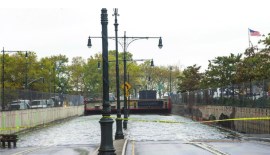
Based on these experiences, BOMA/NY’s report offers a number of communication-themed recommendations. First and foremost, the task force stresses the importance of keeping emergency contact information in multiple places to allow property managers to get in touch with staff and tenants if files are unable to be accessed due to power outages. This includes maintaining a constantly updated hard copy of tenant contact information and backing up all data “in the cloud” or somewhere else offsite. The report also recommends property management teams create a social media account, which building staff, tenants and vendors can follow in case of an emergency. Not only is it an easy way to disseminate information to a large group of people instantaneously, but it also can be updated and accessed regardless of whether or not servers are down. It also is recommended that buildings have at least one analog telephone on the premises. Since these phones do not require electrical power, they will work as long as the phone company’s system is functioning.
Plan and Prepare
There was significant feedback from respondents of BOMA/NY’s survey underscoring the importance of understanding the different types of plans. Many respondents confused New York City-mandated Emergency Action Plans, which are designed for immediate response during a disaster, with emergency preparedness and continuity plans, which are designed to address building preparedness, recovery and restoration processes.
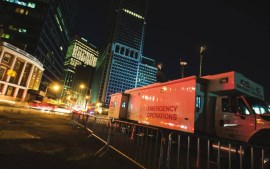
While 62 percent of buildings were estimated to have these more comprehensive emergency preparedness and continuity plans at the time of the storm, according to the survey, many buildings in Sandy’s path did not have plans in place for a disaster of this magnitude. In fact, only 53 percent of the buildings had plans developed for disruptions exceeding one week.
Also not taken into consideration by many property management teams was the effect the storm would have on staff. The majority of respondents said their staffs were housed at their buildings for the duration of the storm. After the storm, limited public transportation in and out of the city, mostly due to the flooding of roads and the subway system, meant that many building crews could not leave the property and relief could not arrive. Food and potable water became scare, emergency supplies began to dwindle and cell phones batteries slowly died.
“When buildings develop an emergency preparedness plan, things overlooked tend to include transportation, fuel and logistics,” says Mike Coleman, vice president of Commercial Real Estate for AlliedBarton Security Services, which provided security personnel for buildings affected by the storm.
“After the storm, it was all about the little things: basic necessities like food, soap, towels and cots. Supplies have a far-reaching effect on recovery. In the wake of the storm, property management teams have updated their plans, adding supplies that were not on the checklists previously and making notations about where there were difficulties,” says Coleman.
Also overlooked by many property management teams during emergency planning was coordination with tenants regarding their emergency protocol and how it complemented the building’s recovery plan. Many tenants and their employees were unaware of the limitations of their buildings and arrived at the property in the days following the storm expecting to be let inside. While Zeccardi’s staff members were able to escort employees up the stairs with flashlights to help them retrieve items from their offices, many buildings were not as fortunate. Some tenants were unaware of provisions in local codes and ordinances that needed to be followed in order for a building to be open at all.
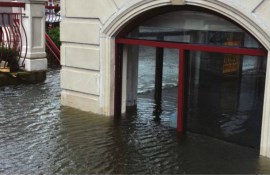
Based on survey results, BOMA/NY also developed a number of preparedness recommendations for future reference. First, property management teams should make sure all preparedness and recovery plans consider disasters of a more prolonged timeframe and have in place measures for staff inhabiting the building for an extended period of time. Second, staff should be cross-trained for redundancy. If a specialized staff member is unable to access an affected building, consider moving, say, a licensed fuel handler from another building in your portfolio that is not affected by the disaster. Lastly, property professionals must be sure to liaise with key tenant contacts to inform them of building recovery procedures and ask them to share this information with their employees. “Even the most prepared buildings had challenges in the wake of Sandy,” says Brandstetter. “However, the more planning the building had, the better off they were.”
Work with Your Vendors
It is critical to coordinate with vendors in advance of a storm to ensure contingency plans are in place, as vendors are not immune to the effects of a disaster either. “Many contractors themselves were severely affected by Sandy,” says Zeccardi, “so the companies that many property management teams relied on in the case of an emergency were not available to help them when these emergencies occurred.”
Security company AlliedBarton was one of many vendors forced to made special arrangements in the face of Sandy. According to Coleman, in order to provide relief assistance and ensure uninterrupted security service for its clients, AlliedBarton gathered upwards of 200 personnel from areas outside of those severely affected by Sandy and shuttled them to the Greater New York area. They commandeered three hotels in New Jersey that were not affected by the storm and created a temporary headquarters for its personnel. These security guards provided an especially important service for buildings that lost power and, therefore, their CCTV, electronic door locks and security systems.
AlliedBarton’s experiences were not unique for vendors in the area hit by Sandy. Forty-two percent of the vendors surveyed by BOMA/NY indicated they had to acquire supplies, equipment and personnel from outside the New York City metropolitan area after Sandy hit to fulfill service requirements.
Coleman offers a few pieces of advice for working with vendors before, during and after a natural disaster. First, he recommends establishing pre-existing contracts and up-front pricing with vendors for providing emergency services. He also suggests asking vendors about their disaster plans, including additional office and supply locations and emergency contact information. Lastly, he recommends making contact with vendors from outside of your immediate area that you can call on in case your first-choice local vendor is crippled by the storm. “Property owners and managers must be sure they cast a wide net when it comes to finding resources during and after a disaster like Sandy,” notes Coleman.
Looking Forward
“The reason why BOMA/NY compiled our report on Hurricane Sandy is because most of the lessons learned can be applied to any jurisdiction in response to any disaster,” notes Giustino. It is simply a matter of adapting the recommendations to a particular situation. As Louis Trimboli, senior real estate manager for CBRE and co-chair of BOMA/NY’s Hurricane Sandy Task Force, explains, “As we learned in New York with Sandy, you must have an understanding of the environment in which your building is operating in order to best prepare for potential disasters. In the Midwest, you might need to be more concerned about tornados, while, on the West Coast, it might be more important to understand earthquakes. However, preparedness is universal.”
Meanwhile, many lessons are still being discovered in the wake of Superstorm Sandy. These include lessons about insurance coverage and legal obligations under leases and mortgage loan documents.
Even as rebuilding is completed, paperwork still looms for many building owners. Many more commercial real estate companies have learned that insurance policies are works in progress and should be reviewed and clarified regularly, well in advance of any disaster.
In the future, building owners and managers will no doubt adjust the way they prepare for disasters in response to the lessons learned through Sandy. In the meantime, the areas most battered by the storm will continue to recover as time passes. Zeccardi sums up the optimism of the Northeast best: “A year later, we’re closer to recovery than we were yesterday, and we’ll definitely be better tomorrow.”
Recommendations adapted from BOMA/NY’s Hurricane Sandy: Lessons Learned Study:
Building Staffing:
- Develop building-level business continuity plans that identify minimum building staffing requirements. Plan to provide minimum staff for an extended period (greater than one week).
- Plan for staff inhabiting the building for an extended period of time; e.g. ensure supplies and equipment are on hand or ordered in time to be available for the incident.
- Encourage staff to have family preparedness plans to minimize stress on staff and family if they are separated during an incident.
- Know and understand the parameters that will impede public transportation.
- Train and cross-train staff on building shutdown procedures.
Information Technology Systems:
- If the building has generator back up, ensure that building servers and IT systems are tied into the system.
- Consider arranging for information to be housed in “the cloud” by a company that specializes in hosting e-mail and data to ensure accessibility from anywhere that has power and internet access.
- Maintain an analog phone in the building. Since these phones do not require electrical power, they will work as long as the phone carrier’s system works.
Disaster Planning and Preparation:
- Understand the difference between emergency response, disaster recovery and business continuity plans.
- Plan for incidents which cause disruptions for greater than one week. Ensure provisions for operating without critical security and life safety systems are included in plans.
- Recovery and restoration plans differ, but should, at a minimum, include: staff contact information, tenant contact information, staff actions and responsibilities, vendor contacts for critical system and supplies, communications and messaging templates and prioritization of restoration activities.
Communications:
- Keep emergency contact information in multiple places to allow property managers to get in touch with staff and tenants if servers are unable to be accessed due to power outages.
- Develop and rehearse call forwarding procedures from individual building to corporate offices, to include messages for those answering forwarded calls at the corporate office. This can be used in the event that telecommunications at individual buildings have failed.
- Ensure contact information in mass notification systems is current and conduct periodic rehearsals with tenants.
- Consider establishing a social media account (such as Twitter) for tenants and vendors to follow. This is an easy way to provide current information to tenants and vendors, regardless of whether or not e-mail, phone or computers are available.
Tenants:
- Reinforce to tenant points of contact the importance of their internal messaging to employees during incidents.
- Consider developing tenant access lists to allow entrance to designated tenants following an incident.
- Educate tenants on building minimum requirements for operations and safety, e.g. what systems must be working in order to allow tenants access to building.
Vendors, Supplies and Equipment:
- Recovery plans should include planning for logistics, to include identifying critical vendor contacts and prioritizing of supply requirements. Ensure pre-incident coordination meetings with all vendors.
- Management should consider having pre-existing contracts with vendors to ensure timely deliveries and service and reasonable costs and terms.
- Management should ask vendors about their disaster plans, to include alternate office locations, alternate means of communications and plans for alternate suppliers.
Insurance and Legal:
- While management of insurance and insurance claims may be handled at the corporate level, building managers should have a basic knowledge of the types of issues that may arise during the insurance claims process.
- Know your legal obligations under your lease and mortgage loan documents.
- Management should make sure the following are up-to-date: building maintenance documentation, all permits, any actions requested by the insurance company and any outstanding issues with agency requirements.
To read BOMA/NY’s complete report, Hurricane Sandy: Lessons Learned Study, visit http://bit.ly/12jISrb.


